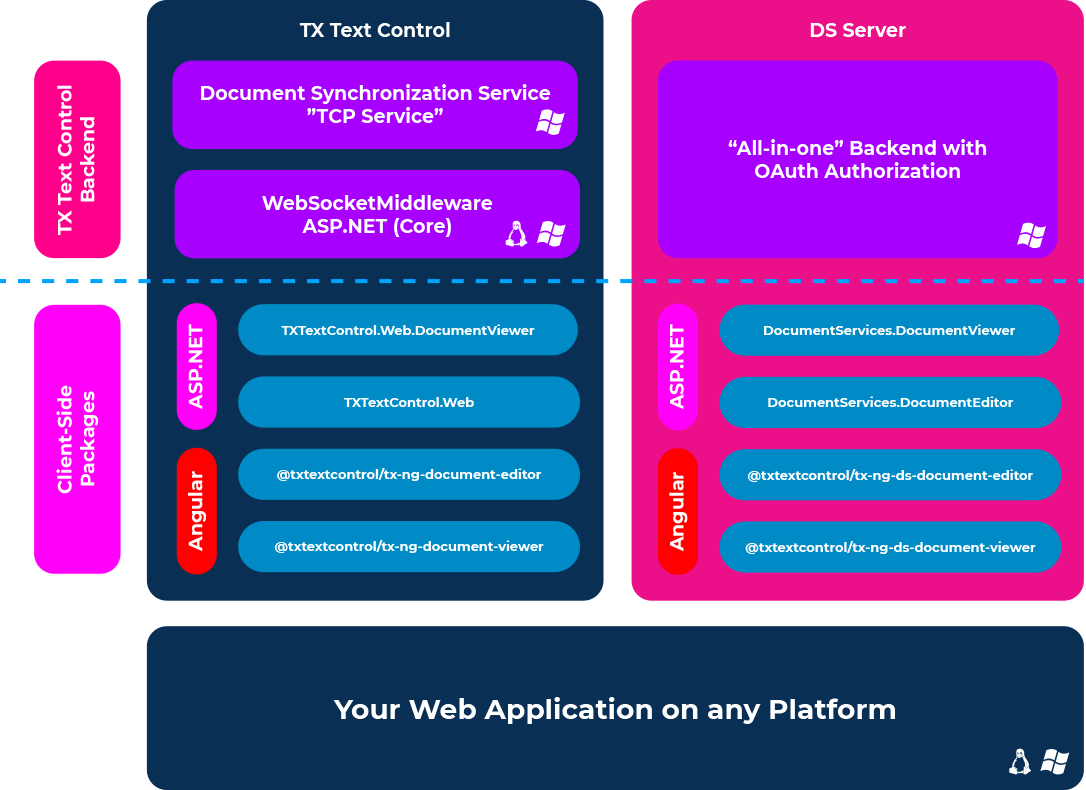Text Control provides a variety of products, packages and technologies to integrate document processing into web applications. Whether you need to add true WYSIWYG document editing, document sharing and collaboration or digital signatures to your business workflows - Text Control provides products for all requirements.
Two Products, One Technology
We provide two different products to add document processing to web applications.
Technically, DS Server is based on the TX Text Control technology and uses the same code-base. Both products give you the tools to integrate document processing into web applications. TX Text Control .NET Server for ASP.NET provides the full access to all libraries and APIs to create and manipulate documents programmatically. DS Server provides a low-code approach for the most typical applications and use-cases.
Deployment
Both TX Text Control and DS Server provide a set of client-side packages to integrate the document editor and viewer into your web applications. In both cases, your web application can be deployed to any platform. But the different products allow a different flexibility when it comes to the deployment.
The following diagram shows the two different products subdivided into the associated client-side packages and their supported backend.

TX Text Control .NET Server for ASP.NET provides the components to create the required backend and they must be implemented in your application. Therefore, the backend is part of your code-base. Using TX Text Control .NET Server for ASP.NET, all assemblies, dependencies and the required backend (WebSocketMiddleware and TCP Service) must be part of your application or can be deployed as a separate application.
DS Server encapsulates the complete required backend and provides a streamlined, out-of-the-box service that can accessed from all of your applications. DS Server is a separate application that runs parallel to your applications that access the document services.
Out-of-the-Box vs. Flexibility
While DS Server provides you an out-of-the-box solution that can be effortlessly connected to your application, TX Text Control provides you more flexibility.
The TX Text Control document editor requires 3 components:
- Client-side package (ASP.NET NuGet, Angular npm)
- Server-side WebSocketHandler (Node.js or ASP.NET on Linux or Windows)
- Document Synchronization TCP Service (Windows)
To synchronize the document and to provide the true WYSIWYG rendering, the client-side component opens a WebSocket connection to the WebSocketHandler. This can be an ASP.NET (Core) Web Application or a Node.js package that is hosted on Windows or Linux. The third required component is the synchronization service that must be hosted on a Windows machine. Thanks to the flexible setup, these 3 components can be deployed independently.
TX Text Control gives your application the flexibility to integrate the required backend directly into your ASP.NET Core web application or to host the required components on different servers without any dependency on Windows.
Deployment Strategies
The TX Text Control document editor requires a server-side backend to synchronize the edited documents. This article gives an overview of best practices deployment strategies.
.NET C# API vs. Web API
Using TX Text Control .NET Server for ASP.NET, you get the full flexibility of the TX Text Control API ( Server
╰ TXTextControl Namespace
╰ ServerTextControl Class
The ServerTextControl class implements a component that provide high-level text processing features for server-based applications. and Mail
╰ DocumentServer Namespace
╰ MailMerge Class
The MailMerge class is a .NET component that can be used to effortlessly merge template documents with database content in .NET projects, such as ASP.NET web applications, web services or Windows services. ) and the assemblies are part of your application. With DS Server, task-oriented Web APIs are available to call document processing methods.
If you need help with finding the product that fits your requirements, feel free to contact our technical team to discuss your project. We are more than happy to help you with your document processing needs.






